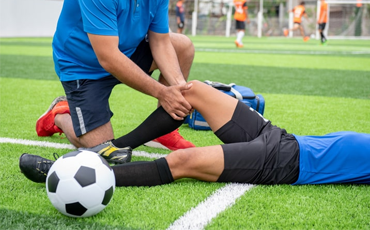Sports injuries occur during exercise or while participating in a sport. Children are particularly at risk for these types of injuries, but adults can get them, too. You’re at risk for sports injuries if you: haven’t been regularly active. don’t warm up properly before exercise. play contact sports.
Types of sports injuries
Different sports injuries produce different symptoms and complications. The most common types of sports injuries include:
1. Sprains. Overstretching or tearing the ligaments results in a sprain. Ligaments are pieces of tissue that connect two bones to one another in a joint.
2. Strains. Overstretching or tearing muscles or tendons results in a sprain. Tendons are thick, fibrous cords of tissue that connect bone to muscle. Strains are commonly mistaken for sprains. Here’s how to tell them apart.
3. Knee injuries. Any injury that interferes with how the knee joint moves could be a sports injury. It could range from an overstretch to a tear in the muscles or tissues in the knee.
4. Swollen muscles. Swelling is a natural reaction to an injury; swollen muscles may also be painful and weak.
5. Achilles tendon rupture. The Achilles tendon is a thin, powerful tendon at the back of your ankle. During sports, this tendon can break or rupture. When it does, you may experience sudden, severe pain and difficulty walking.
Fracture Treatment:
Fractures, or broken bones, are a common concern in sports-related injuries and can result from high-impact trauma, overuse, or underlying bone conditions. At Medwin Ortho Clinic, Dr. Abhijit Landge offers expert Fracture Treatment in Wagholi, focusing on precise diagnosis, accurate realignment, and effective healing to help patients recover and return to an active lifestyle.
Fracture Treatment Options by Dr. Abhijit Landge
● Immobilization :
Utilizing casts, splints, or braces to restrict movement and allow the bone to heal naturally.
● Closed Reduction :
Manually realigning the fractured bone without the need for surgical incisions.
● Bone Fracture Surgery :
When conservative methods aren’t enough, surgical intervention is performed to correct and stabilize the fracture.
● Internal Fixation :
Surgically implanting hardware such as plates, screws, or rods to secure the bone fragments in proper alignment.
● External Fixation :
Applying an external frame connected to the bone through pins or wires, particularly effective for managing complex or open fractures.
● Arthroplasty :
Performing joint replacement surgery when fractures result in significant joint damage, thereby restoring joint function.
● Bone Grafting :
Transplanting bone tissue to stimulate healing and promote the union of fractured segments, especially in cases of severe bone loss or non-union.


